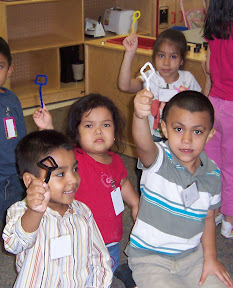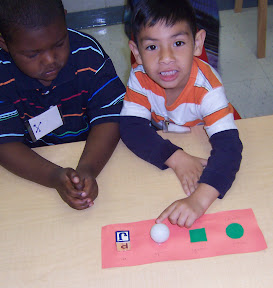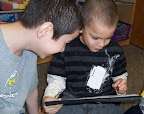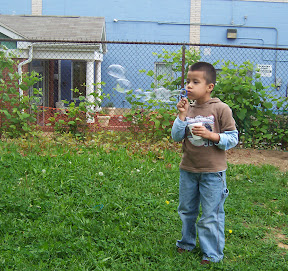
From the Early Years photo cache (click on the pics for more).
The children were happy that I had enough of each color pipe cleaner (known as “fuzzy sticks” nowadays) that everyone could choose their favorite color. We wanted to make bubbles and needed to make bubble wands.
Children like to have choices (as do I). Choosing marker color, place in line, type of seed to plant, or which center in which to begin their day, can be so important for young children that they are willing to overcome shyness or difficulty with language to voice their choice. Being encouraged to choose and plan helps children develop thinking, and talking about what they might do in the future—important for science because part of being able to make predictions is to think about what has not yet happened.
 After the class watched as I made bubbles of air in water, I asked the children to predict what shape bubble I could make with a square shaped bubble wand dipped in soap solution. My purpose was to raise a question in their minds, “What shape can bubbles be?” and ask the children to predict based on prior knowledge before going outside to blow bubbles. They had four shapes they could point to, to show their prediction, and we reviewed their names, square, cube, circle, sphere. The children pointed to the ball shape even as they said, “Circle.” They knew what they meant but were not yet familiar enough with the word “sphere” to use it. I use the word “round” much more often than “sphere”. If only sphere were a little easier to pronounce!
After the class watched as I made bubbles of air in water, I asked the children to predict what shape bubble I could make with a square shaped bubble wand dipped in soap solution. My purpose was to raise a question in their minds, “What shape can bubbles be?” and ask the children to predict based on prior knowledge before going outside to blow bubbles. They had four shapes they could point to, to show their prediction, and we reviewed their names, square, cube, circle, sphere. The children pointed to the ball shape even as they said, “Circle.” They knew what they meant but were not yet familiar enough with the word “sphere” to use it. I use the word “round” much more often than “sphere”. If only sphere were a little easier to pronounce!
 Recording a prediction or observation with tally marks is a kind of choice, but young children may not understand that they are choosing a representation of what they think or a reality that they have observed. On Friday in a large group follow-up to an activity where all the children moved water from container to container using various tools(see 3/22/09 post: Using tools to move water), one student was advocating for others to choose his choice of “favorite” tool. When we see children trying to influence their friends’ choice in recording a personal prediction or observation, we know that the child does not understand the purpose of tallying the predictions and observations.
Recording a prediction or observation with tally marks is a kind of choice, but young children may not understand that they are choosing a representation of what they think or a reality that they have observed. On Friday in a large group follow-up to an activity where all the children moved water from container to container using various tools(see 3/22/09 post: Using tools to move water), one student was advocating for others to choose his choice of “favorite” tool. When we see children trying to influence their friends’ choice in recording a personal prediction or observation, we know that the child does not understand the purpose of tallying the predictions and observations.
Anyone have ideas for helping children understand that recording observations is not voting?
Here are two resources on early childhood and making choices:
- The HighScope Educational Research Foundation, “an independent nonprofit research, development, training, and public outreach organization with headquarters in Ypsilanti, Michigan.” Research shows that planning and reviewing are the two components of the program day most positively and significantly associated with children’s scores on measures of developmental progress.
- The Alliance for Childhood “promotes policies and practices that support children’s healthy development, love of learning, and joy in living.” See the Alliance’s graphic about the continuum of children’s choice play in kindergartens.
What kind of choices in your class support science learning? Tell the rest of us about what your students choose by adding a comment. Click on the word “comment” below. Hint: write and save your comment in a separate document to cut and paste in, because the anti-spammer “capcha” box may time out before you are ready to submit your comment.
Looking forward to learning from you,
Peggy




 If you’d like a copy of the NSTA Inquiry wordle as a pdf file,
If you’d like a copy of the NSTA Inquiry wordle as a pdf file, 




